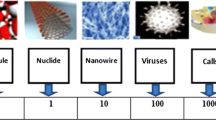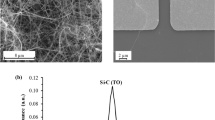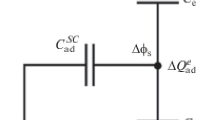Abstract
For the development of ultra-sensitive electrical bio/chemical sensors based on nanowire field effect transistors (FETs), the influence of the ions in the solution on the electron transport has to be understood. For this purpose we establish a simulation platform for nanowire FETs in the liquid environment by implementing the modified Poisson-Boltzmann model into Landauer transport theory. We investigate the changes of the electric potential and the transport characteristics due to the ions. The reduction of sensitivity of the sensors due to the screening effect from the electrolyte could be successfully reproduced. We also fabricated silicon nanowire Schottky-barrier FETs and our model could capture the observed reduction of the current with increasing ionic concentration. This shows that our simulation platform can be used to interpret ongoing experiments, to design nanowire FETs, and it also gives insight into controversial issues such as whether ions in the buffer solution affect the transport characteristics or not.

Similar content being viewed by others
References
Iijima, S. Helical microtubules of graphitic carbon. Nature 1991, 354, 56–58.
Saito, R.; Dresselhaus, G.; Dresselhaus, M. S. Physical properties of carbon nanotubes; Imperial College Press: London, 1998.
Wagner, R. S.; Ellis, W. C. Vapor-liquid-solid mechanism of single crystal growth. Appl. Phys. Lett. 1964, 4, 89–90.
Westwater, J.; Gosain, D. P.; Tomiya, S.; Usui, S.; Ruda, H. Growth of silicon nanowires via gold/silane vapor-liquidsolid reaction. J. Vac. Sci. Technol. B 1997, 15, 554–557.
Schmidt, V.; Wittemann, J. V.; Gösele, U. Growth, thermodynamics, and electrical properties of silicon nanowires. Chem. Rev. 2010, 110, 361–388.
Rurali, R. Colloquium: Structural, electronic, and transport properties of silicon nanowires. Rev. Mod. Phys. 2010, 82, 427–449.
Tans, S. J.; Verschueren, A. R. M.; Dekker, C. Room- temperature transistor based on a single carbon nanotube. Nature 1998, 393, 49–52.
Martel, R.; Schmidt, T.; Shea, H. R.; Hertel, T.; Avouris, Ph. Single- and multi-wall carbon nanotube field-effect transistors. Appl. Phys. Lett. 1998, 73, 2447–2449.
Cui, Y.; Wei, Q.; Park, H.; Lieber, C. M. Nanowire nanosensors for highly sensitive and selective detection of biological and chemical species. Science 2001, 293, 1289–1292.
Kong, J.; Franklin, N. R.; Zhou, C.; Chapline, M. G.; Peng, S.; Cho, K.; Dai, H. Nanotube molecular wires as chemical sensors. Science 2000, 287, 622–625.
Lauhon, L. J.; Gudiksen, M. S.; Wang, D.; Lieber, C. M. Epitaxial core-shell and core-multishell nanowire heterostructures. Nature 2002, 420, 57–61.
Comini, E.; Faglia, G.; Sberveglieri, G.; Pan, Z.; Wang, Z. L. Stable and highly sensitive gas sensors based on semiconducting oxide nanobelts. Appl. Phys. Lett. 2002, 81, 1869–1871.
Hahm, J.; Lieber, C. M. Direct ultrasensitive electrical detection of DNA and DNA sequence variations using nanowire nanosensors. Nano Lett. 2004, 4, 51–54.
Heinze, S.; Tersoff, J.; Martel, R.; Derycke, V.; Appenzeller, J.; Avouris, Ph. Carbon nanotubes as Schottky barrier transistors. Phys. Rev. Lett. 2002, 89, 106801.
Appenzeller, J. M.; Radosavljevic, M.; Knoch, J.; Avouris, Ph. Tunneling versus thermionic emission in one-dimensional semiconductors. Phys. Rev. Lett. 2004, 92, 048301.
Nair, P. R.; Alam, M. A. Design considerations of silicon nanowire biosensors. IEEE Trans. Elec. Dev. 2007, 54, 3400–3408.
Heitzinger, C.; Kennell, R.; Klimeck, G.; Mauser, N.; McLennan, M.; Ringhofer, C. Modeling and simulation of field-effect biosensors (biofets) and their deployment on the NanoHub. J. Phys.: Conf. Ser. 2008, 107, 012004.
Birner, S.; Hackenbuchner, S.; Sabathil, M.; Zandler, G.; Majewski, J. A.; Andlauer, T.; Zibold, T.; Morschl, R.; Trellakis, A.; Vogl, P. Modeling of semiconductor nanostructures with nextnano3. Acta Phys. Polon. 2006, 111, 111–115.
Lee, J.; Shin, M.; Ahn, C. G.; Ah, C. S.; Park, C. W.; Sung, G. Y. Effects of pH and ion concentration in a phosphate buffer solution on the sensitivity of silicon nanowire bioFETs. J. Korean Phys. Soc. 2009, 55, 1621–1625.
Elfström, N.; Juhasz, R.; Sychugov, I.; Engfeldt, T.; Karlström, A. E. Surface charge sensitivity of silicon nanowires: Size dependence. Nano Lett. 2007, 7, 2608–2612.
Chen, Y.; Wang, X.; Erramilli, S.; Mohanty, P.; Kalinowski, A. Silicon-based nanoelectronic field-effect pH sensor with local gate control. App. Phys. Lett. 2006, 89, 223512.
Li, Z.; Chen, Y.; Li, X.; Kamins, T. I.; Nauka, K.; Williams, R. S. Sequence-specific label-free DNA sensors based on silicon nanowires. Nano Lett. 2004, 4, 245–247.
Fan, Z.; Lu, J. G. Gate-refreshable nanowire chemical sensors. Appl. Phys. Lett. 2005, 86, 123510.
Stern, E.; Wagner, R.; Sigworth, F. J.; Breaker, R.; Fahmy, T. M.; Reed, M. A. Importance of the Debye screening length on nanowire field effect transistor sensors. Nano Lett. 2007, 7, 3405–3409.
Kurkina, T.; Vlandas, A.; Ahmad, A.; Kern, K.; Balasubramanian, K. Label-free detection of few copies of DNA with carbon nanotube impedance biosensors. Angew. Chem. Int. Ed. 2011, 50, 3710–3714.
Russel, W. B.; Saville, D. A.; Schowalter, W. R. Colloidal Dispersions; Cambridge University Press: Cambridge, 1989.
Borukhov, I.; Andelman, D.; Orland, H. Steric effects in electrolytes: A modified Poisson-Boltzmann equation. Phys. Rev. Lett. 1997, 79, 435–438.
Pham, P.; Howorth, M.; Planat-Chretien, A.; Tardu, S. Numerical simulation of the electrical double layer based on the Poisson-Boltzmann models for ac electroosmosis flows. COMSOL Users Conference 2007, Grenoble, 2007.
Kilic, M. S.; Bazant, M. Z.; Ajdari, A. Steric effects in the dynamics of electrolytes at large applied voltages. I. Double-layer charging. Phys. Rev. E 2007, 75, 021502.
Kilic, M. S.; Bazant, M. Z.; Ajdari, A. Steric effects in the dynamics of electrolytes at large applied voltages. II. Modified Poisson-Nernst-Planck equations. Phys. Rev. E 2007, 75, 021503.
Nozaki, D.; Kunstmann, J.; Zörgiebel, F.; Weber, W. M.; Mikolajick, T.; Cuniberti, G. Multiscale modeling of nanowirebased Schottky-barrier field-effect transistors for sensor applications. Nanotechnology 2011, 22, 325703.
COMSOL Multiphysics, version 3.5 http://www.comsol.com.
Datta, S. Electronic Transport in Mesoscopic Systems; Cambridge University Press: Cambridge, 1995.
Clément, N.; Nishiguchi, K.; Dufreche, J. F.; Guerin, D.; Fujisawa, A.; Vuillaume, D. A silicon nanowire ion-sensitive field-effect transistor with elementary charge sensitivity. Appl. Phys. Lett. 2001, 98, 014104.
Knopfmacher, O.; Tarasov, A.; Wipf, M.; Fu, W.; Calame, M.; Schönenberger, C. Silicon-based ion-sensitive field-effect transistor shows negligible dependence on salt concentration at constant pH. ChemPhysChem 2012, 13, 1157–1160.
Nikolaides, M. G.; Rauschenbach, S.; Luber, S.; Buchholz, K.; Tornow, M.; Abstreiter, G.; Bausch, A. R. Silicon-on-insulator based thin-film resistor for chemical and biological sensor applications. ChemPhysChem 2003, 4, 1104–1106.
Park, I.; Li, Z.; Pisano, A. P.; Williams, R. S. Top-down fabricated silicon nanowire sensors for real-time chemical detection. Nanotechnology 2010, 21, 015501.
Weber, W. M.; Geelhaar, L.; Graham, A. P.; Unger, E.; Duesberg, G. S.; Liebau, M.; Pamler, W.; Chèze, C.; Riechert, H.; Lugli, P.; Kreupl, F. Silicon-nanowire transistors with intruded nickel-silicide contacts. Nano Lett. 2010, 6, 2660–2666.
Pregl, S.; Weber, W. M.; Nozaki, D.; Kunstmann, J.; Baraban, L.; Optiz, J.; Mikolajick, T.; Cuniberti, G. Parallel arrays of Schottky barrier nanowire field effect transistors: Nanoscopic effects for macroscopic current output. Nano Res. 2013, 6, 381–388.
Author information
Authors and Affiliations
Corresponding author
Electronic supplementary material
Rights and permissions
About this article
Cite this article
Nozaki, D., Kunstmann, J., Zörgiebel, F. et al. Ionic effects on the transport characteristics of nanowire-based FETs in a liquid environment. Nano Res. 7, 380–389 (2014). https://doi.org/10.1007/s12274-013-0404-9
Received:
Revised:
Accepted:
Published:
Issue Date:
DOI: https://doi.org/10.1007/s12274-013-0404-9




